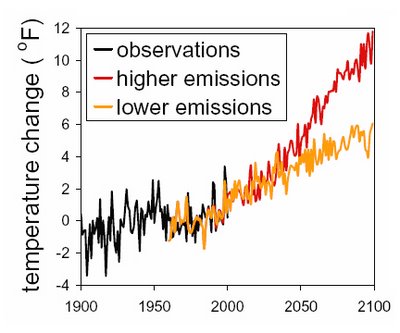Climate Change in the U.S. Northeast

I received an email message from the Union for Concerned Scientists about a month ago which advertised a "new report detailing how global warming is poised to substantially change the climate in the Northeast." The email went on to summarize the report's findings that, by late-century:
- Northeast winters could warm by eight to 12 degrees Fahrenheit and summers by six to nearly 14 degrees.
- The length of the region’s winter snow season could be cut in half.
- The frequency of short-term droughts could increase significantly.
- Sea-level could rise from eight inches to as much three feet.
- Many Northeast cities can expect about 25 days per year over 100 degrees. (Currently, Northeast cities experience this type of heat only once or twice a year.)
Because I teach on this topic and because it is extremely relevant to my research, I immediately obtained the report. As I suspected from the frequent use of the world "could" in the message above, the report is a forecast using a computer model. The scientists who wrote the report do have excellent credentials, but some of the UCS literature clearly overstates their findings. The forecasted temperature changes use a "higher emissions" scenario in which we continue to increase our combustion of fossil fuels. The model also seems to assume that temperature increases one-for-one with carbon dioxide. Few atmospheric chemists support this, although it is also prominently featured in Al Gore's "An Inconvenient Truth."
What caught my eye first were the forecasts for a shorter snow season and more droughts. I knew from my own research that annual precipitation has been going up in most states in the Northeast, a fact which I and many other climate scientists suspect is being driven by rising temperatures. In fact, the report does note a gradual increase since 1900 of about 5 to 10 percent in annual average precipitation across the Northeast. Winter precipitation, in particular, has increased at up to 0.15 inch per decade. The model forecasts assume that drastic future temperature changes will cause this winter precipitation to include more rain than snow. Although there are detailed discussions written by meteorologists in the report, there does not seem to be much physics or chemistry in this "model." Instead, it appears to be a mapping exercise where state climatic parameters are moved around to make pretty graphics.
I happen to believe that the temperature of our atmosphere increased during the 20th century and is continuing to do so. I also happen to believe that some of that increase is due to fossil fuel combustion. However, I worry that simplification of scientific findings and forecasts using unlikely "worst-case scenarios" will produce a backlash rather than the intended awakening in the American public. Similarly, I am not much enamored of fantasies about "geoengineering" a cooler climate which have recently gotten press here and here. Rather than maps of the sort featured in the UCS report, I would like to see models based upon physical and chemical equations which address feedbacks and adjustments of the climate system.
Labels: Climate, Global Warming, Quaternary



0 Comments:
Post a Comment
Subscribe to Post Comments [Atom]
<< Home